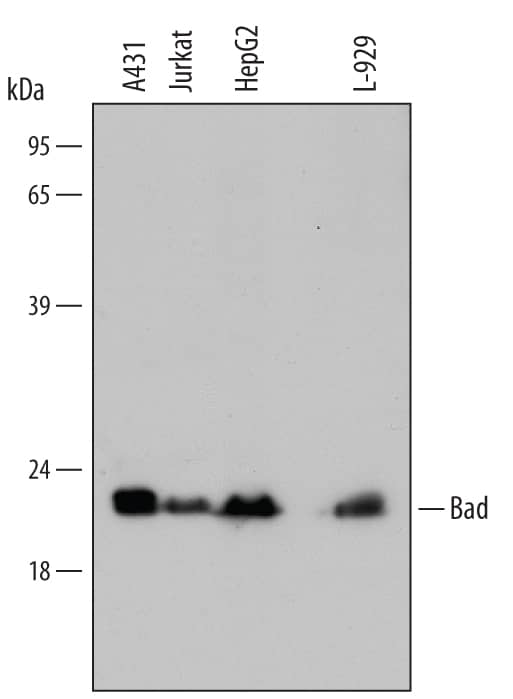Human/Mouse Bad aa 1‑21 Antibody
R&D Systems, part of Bio-Techne | Catalog # AF819

Key Product Details
Species Reactivity
Validated:
Cited:
Applications
Validated:
Cited:
Label
Antibody Source
Product Specifications
Immunogen
MFQIPEFEPSEQEDSSSAERGC
Accession # Q92934
Specificity
Clonality
Host
Isotype
Scientific Data Images for Human/Mouse Bad aa 1‑21 Antibody
Detection of Human/Mouse Bad by Western Blot.
Western blot shows lysates of A431 human epithelial carcinoma cell line, Jurkat human acute T cell leukemia cell line, HepG2 human hepatocellular carcinoma cell line, and L-929 mouse fibroblast cell line. PVDF membrane was probed with 1 µg/mL of Rabbit Anti-Human/Mouse Bad Antigen Affinity-purified Polyclonal Antibody (Catalog # AF819) followed by HRP-conjugated Anti-Rabbit IgG Secondary Antibody (Catalog # HAF008). A specific band was detected for Bad at approximately 22 kDa (as indicated). This experiment was conducted under reducing conditions and using Immunoblot Buffer Group 2.Bad in Jurkat Human Cell Line.
Bad was detected in immersion fixed Jurkat human acute T cell leukemia cell line using Rabbit Anti-Human/Mouse Bad Antigen Affinity-purified Polyclonal Antibody (Catalog # AF819) at 0.3 µg/mL for 3 hours at room temperature. Cells were stained using the NorthernLights™ 557-conjugated Anti-Rabbit IgG Secondary Antibody (red; Catalog # NL004) and counterstained with DAPI (blue). Specific staining was localized to cytoplasm. View our protocol for Fluorescent ICC Staining of Non-adherent Cells.Applications for Human/Mouse Bad aa 1‑21 Antibody
Immunocytochemistry
Sample: Immersion fixed Jurkat human acute T cell leukemia cell line
Western Blot
Sample: A431 human epithelial carcinoma cell line, Jurkat human acute T cell leukemia cell line, HepG2 human hepatocellular carcinoma cell line, and L‑929 mouse fibroblast cell line
Reviewed Applications
Read 2 reviews rated 4 using AF819 in the following applications:
Formulation, Preparation, and Storage
Purification
Reconstitution
Formulation
Shipping
Stability & Storage
- 12 months from date of receipt, -20 to -70 °C as supplied.
- 1 month, 2 to 8 °C under sterile conditions after reconstitution.
- 6 months, -20 to -70 °C under sterile conditions after reconstitution.
Background: Bad
Bcl-2 antagonist of cell death (BAD) is an 18 kDa cytoplasmic protein in the Bcl-2 family. It functions as a pro-apoptotic molecule by dimerizing with and inhibiting the anti-apoptotic proteins Bcl-2 and Bcl-xL. Prosurvival signals trigger the phosphorylation of BAD on Ser115, disrupting its interaction with Bcl-2 and Bcl-xL and resulting in protection from apoptosis. Over amino acid 1-21, human BAD shares 81 % aa sequence identity with mouse and rat BAD.
Long Name
Alternate Names
Gene Symbol
UniProt
Additional Bad Products
Product Documents for Human/Mouse Bad aa 1‑21 Antibody
Product Specific Notices for Human/Mouse Bad aa 1‑21 Antibody
For research use only

